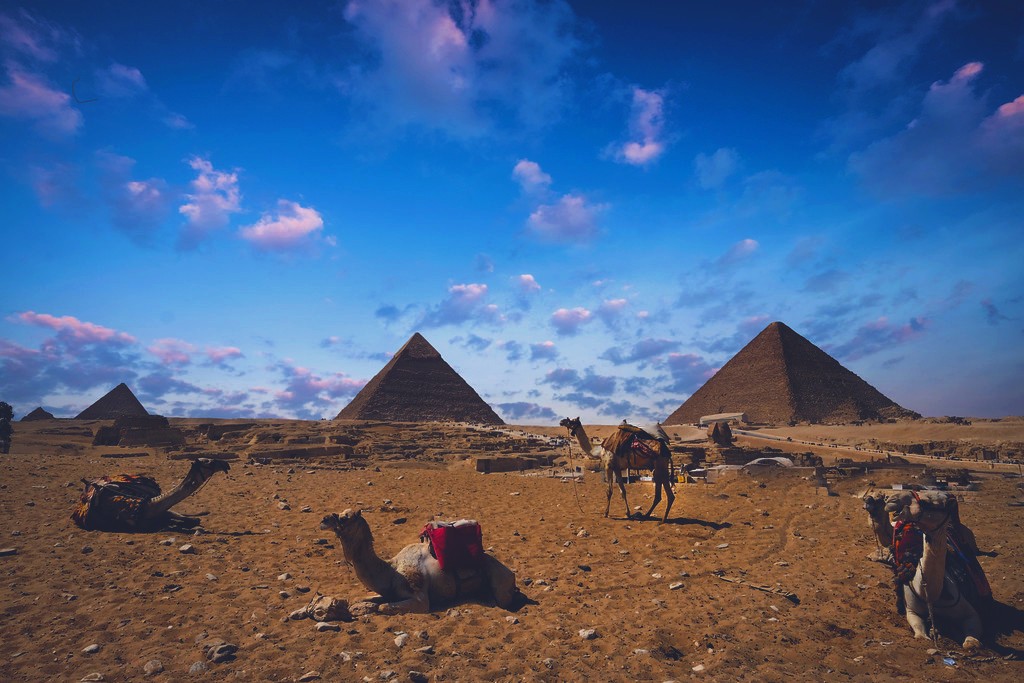
Pyramids of Giza
No ancient landmark has marveled the human race as much as the Pyramids of Giza. Poets and painters throughout history have tried to capture the astounding nature of these ancient wonders, leaving readers and viewers yearning for a chance to visit them and revel in their reality. Travelers to Egypt continue to be astonished by the 4,500 old tombs that have now become synonymous with the country.
The sheer magnitude and impressive construction of the Pyramids has led many to speculate about their origins, with some going so far as to suggest that they were built by ancient aliens. But the human origin of these massive tombs is just as impressive. The astonishing structures were built by local skilled workers for three pharaohs of the Fourth Dynasty, Khufu, his son Khafre, and his grandson Menkaure. A nearby temporary worker village housed approximately 20,000 people, including construction workers and supporting laborers like carpenters and bakers. Archaeological evidence suggests that the large stones quarried nearby were moved into position using sleds and an elaborate ramp system.
The Pyramid of Khufu
The Pyramid of Khufu, also known as the Great Pyramid of Giza, is the oldest of the Seven Wonders of the Ancient World and the only one still in existence. The pyramid is the oldest of the pyramids and at 455 feet high, the largest. It has been estimated that building the impressive construction, which weighs 6.5 million tons and was the tallest building in the world for nearly 4,000 years, today would cost $5 billion. It is made up of an estimated 2.3 million blocks and was originally encased in polished white limestone which gave it a shiny appearance. These encasement blocks were removed over time by natural disasters and by later leaders who used them to build mosques and fortresses, most notably the Mosque of Mohamed Ali.
The Pyramid of Khafre
Commissioned by Khufu’s son Khafre, this pyramid is the second largest at 448 feet tall, despite this, it appears taller than Khufu’s Great Pyramid as it sits on a higher bedrock. Unlike his father’s, Khafre’s pyramid is still topped with its original polished limestone casing. Many historians believe that the Sphinx was also built for the king who reigned for over 20 years, due to its proximity to Khafre’s pyramid temple complex. The face of the sphinx also highly resembles statues of Khafre, including a life size statue of the king found nearby in the 1800s.
The Pyramid of Menkaure
The smallest of the pyramids of Giza was commissioned by Menkaure, Khafre’s son. Originally standing at 215 feet, it now stands at 204 feet. While his pyramid was the smallest, Menkaure’s temple complex is more elaborate and grand than that of his grandfather, Khufu. Thousands of years following their construction, Saladin’s son the Sultan al-Aziz Uthman ordered the demolition of the Pyramids of Giza, starting with Menkaure’s pyramid. The Sultan’s labourers painstakingly removed stones from the pyramid for eight months; however, the task proved too big. Al-Aziz Uthman abandoned the project, leaving a distinct vertical opening on the northern side of Menkaure’s Pyramid.


Mark
Thanks for your blog, nice to read. Do not stop.